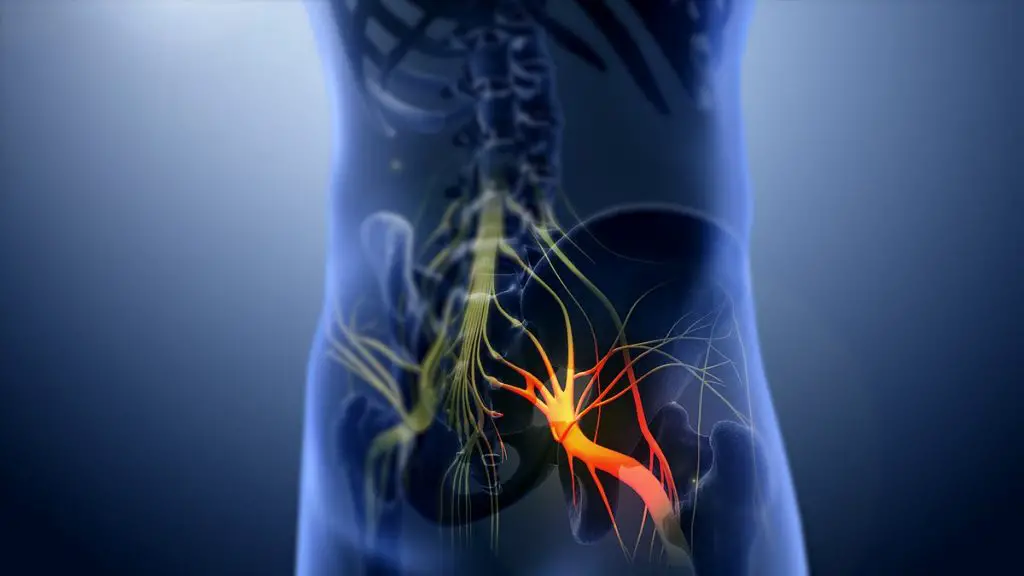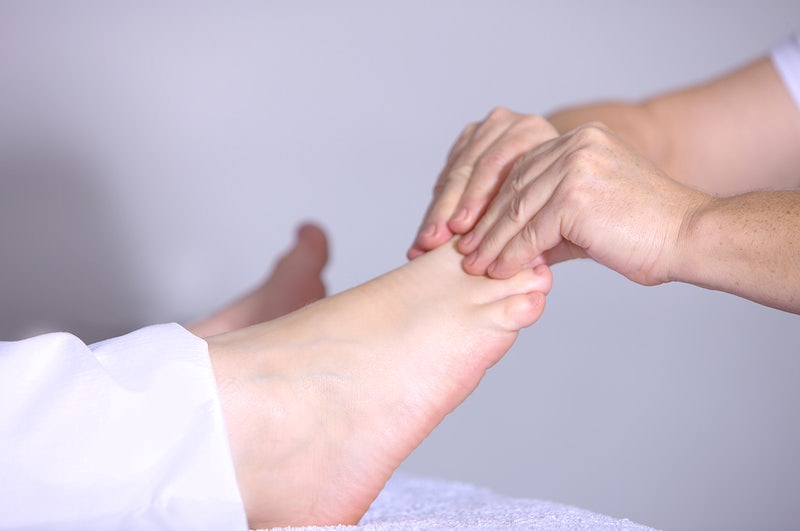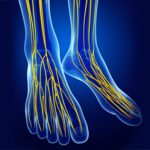La sciatica is a condition that occurs when the nerve sciatica, the largest nerve in the body, is inflamed or irritated. This can cause pain, tingling and numbness in lower back and legs.
In many cases, the sciatica goes away on its own within a few weeks. However, in some cases, it may be a sign of something more serious and may require treatment.
In this article, we will explore the possible causes of your sciatica, and how you can be relieved! More specifically, we will discuss the compressed nerve myth, and the actual explanation behind it. sciatic nerve stuck up.
Notions of anatomy
Before discussing pinched nerves, let's recall a few anatomy concepts that will help you better visualize the spine and the sciatic nerve.
Spine
The support of the body is provided primarily by the spine. This is formed by stacking several vertebrae, including 7 cervical vertebrae, 12 dorsal vertebrae, 5 lumbar vertebrae, 5 fused sacrum vertebrae and 4 coccyx vertebrae.
Le Lumbar spine represents the moving part of the spine. It should be noted that the spinal cord ends at the level of the lumbar vertebrae, through which the nerves exit.
The sciatic nerve
Le sciatic nerve guarantees the sensitivity and motor skills of the lower limbs, which makes it a mixed nerve. It is flattened and oval in shape, being the largest and longest nerve in the body. The sciatic nerve then arises from a lumbosacral plexus. The latter is formed thanks to the junction of the five spinal nerves which emanate from the vertebrae L4, L5, S1, S2 and S3.
In both lower limbs, the nerve path begins in the lower back and continues to the pelvis, buttock, thigh, leg and foot.
If you want to get more information about the anatomy and course of the sciatic nerve, you can click here.
Focus on sciatica
The term sciatica describes the symptoms of leg pain – and possibly tingling, numbness or weakness – that starts in the lower back and travels down the buttock to the great nerve sciatica located at the back of each leg.
Several different pathologies can compress or irritate the nerve sciatica and cause a sciatica :
The most common is the herniated disc, which results in the rupture or extrusion of a disc located between the vertebrae. This can cause nerve irritation responsible for radiation in the leg.
Other causes of sciatica include:
- lumbar osteoarthritis,
- La spinal stenosis ou narrow lumbar canal (a narrowing of the spinal canal)
- Le spondylolisthesis
- The pregnancy
- etc.
La sciatica can be very painful. The pain usually radiates from the lower back to the thigh, then down the leg to the foot. You may feel a sharp pain or a dull ache.
The pain can range from mildly irritating to debilitating, making it difficult to get up or walk. You may also feel tingling numbness or weakness in your leg.
The symptoms of sciatica may vary depending on which part of the nerve is compressed or irritated. In the majority of cases, only one side of the body is affected. In other more complex cases, both sides can be affected.
Common treatments for sciatica
La sciatica is one of the most common and painful conditions affecting the lower back and legs. The good news is that there are a number of effective treatment options.
In most cases, ice or heat, along with rest and over-the-counter pain relievers, are sufficient to ease the pain.
For more stubborn cases, various other strategies may be effective, including exercises of the McKenzie method, lumbar traction et seepage.
In some cases, alternative therapies such as naturopathy, acupuncture or myotherapy can also provide relief. Whichever approach you take, it's important to be patient and consistent in order to give your body the time it needs to heal.
Nerf sciatica stuck, really?
The term " pinched nerve is often used to describe a variety of symptoms, but it is not a diagnosis. In fact, the pinched nerve is a very rare instance, and constitutes a severe attack whose prognosis is reserved.
La compression of a nerve refers to any type of external force that compresses the nerve against a bone or other tissue. This would be manifested by pain of the neuropathy type (electric shock), significant paresthesias and significant motor impairment (such as paralysis).
However, sciatica comes with more manageable symptoms, although they are often bothersome. As mentioned, moderate pain is often observed associated with numbness, tingling and/or weakness of the affected limb.
In fact, the pinched nerve rather refers to an irritated sciatic nerve and causing an inflammatory process. This irritation can be caused by one of the causes mentioned above.
Certainly, if the irritation is severe enough, it can interfere with the nerve's ability to transmit signals, and cause more significant symptoms. However, it is not scientifically plausible that a person has a nerve sciatica " stuck ".
Furthermore, there is no scientific evidence to support the claim that a nerve sciatica may be compressed, jammed, or blocked.
Nerf sciatica Stuck: Nerve Pain Does Not Mean Stuck Nerve
Nerve pain can be caused by a number of different things, but a pinched nerve is just one "possible" culprit. Nerve pain is often characterized by burning or tingling sensation, as well as numbness or weakness.
In some cases, the pain may be sharp or throbbing. There are a number of other potential causes of nerve pain, including inflammation, infection, and damage to the nerves themselves.
How to “unblock” the nerve sciatica : What to do ? (The real answer)
Many people with pain sciaticaPeople turn to conservative measures such as rest, ice or heat therapy, gentle stretching, and over-the-counter pain medications.
If these methods do not provide relief after a while, some people may opt for more invasive treatments such as infiltrations adapted according to the cause.
However, there is another way to "unblock" the nerve sciatica. This method is surgical, and also depends on the source of the problem. Nerve release can be done via laminectomy, microdiscectomy, etc.
Nerf sciatica stuck: Are osteopathic techniques effective?
There are a large number of osteopathic techniques that can be used to treat various ailments. A common technique is manual therapy, which involves using the hands to apply pressure to the affected area.
This can help relieve pain and promote healing. One can also perform gentle stretches and pull-ups to improve range of motion and reduce inflammation.
Osteopathic techniques, such as osteopathic manipulative therapy (OMT), can be effective in reducing nerve irritation. However, these techniques do not remove the nerve itself. The goal of OMT is to reduce pressure on the nerve, which can help reduce pain and improve function.
In many cases OMT can provide significant symptom relief, but this does not mean that the osteopath has unblocked or unblocked the sciatic nerve as such. Additionally, passive techniques most often provide temporary relief, and should be combined with active techniques (such as adaptive exercises) to optimize results.











